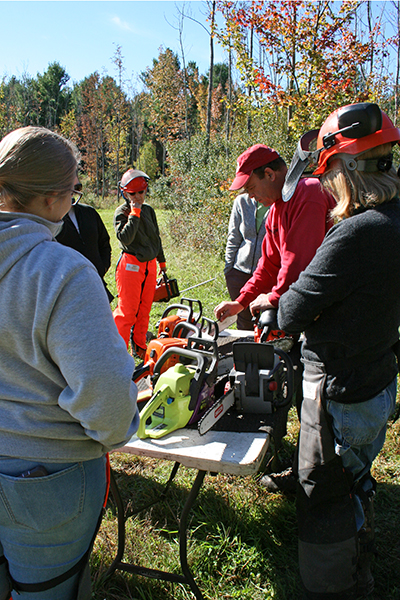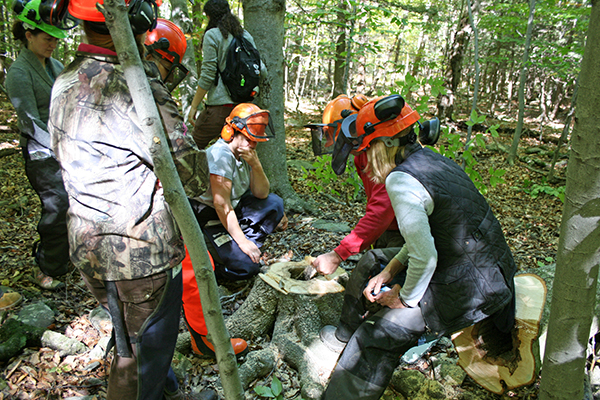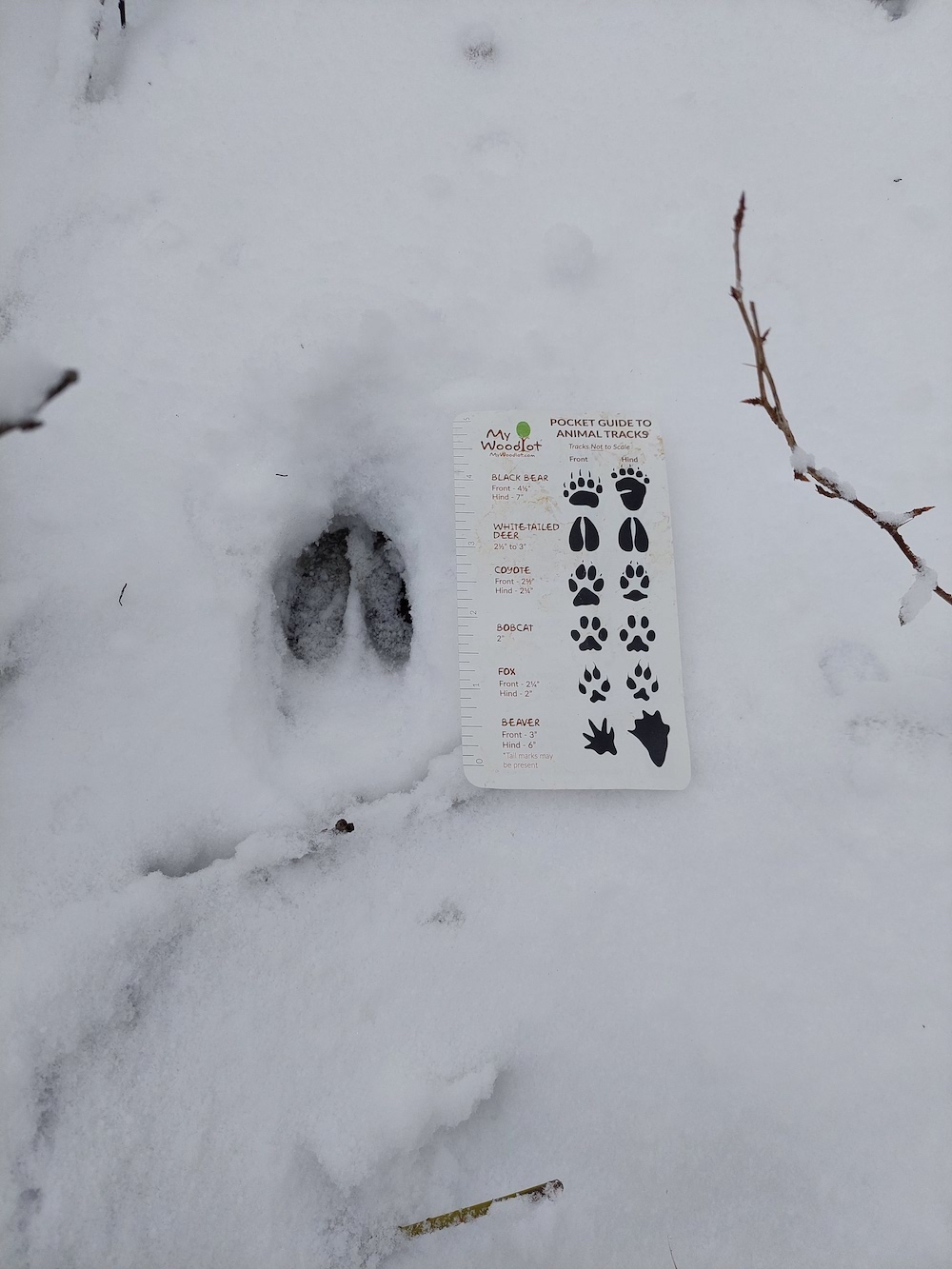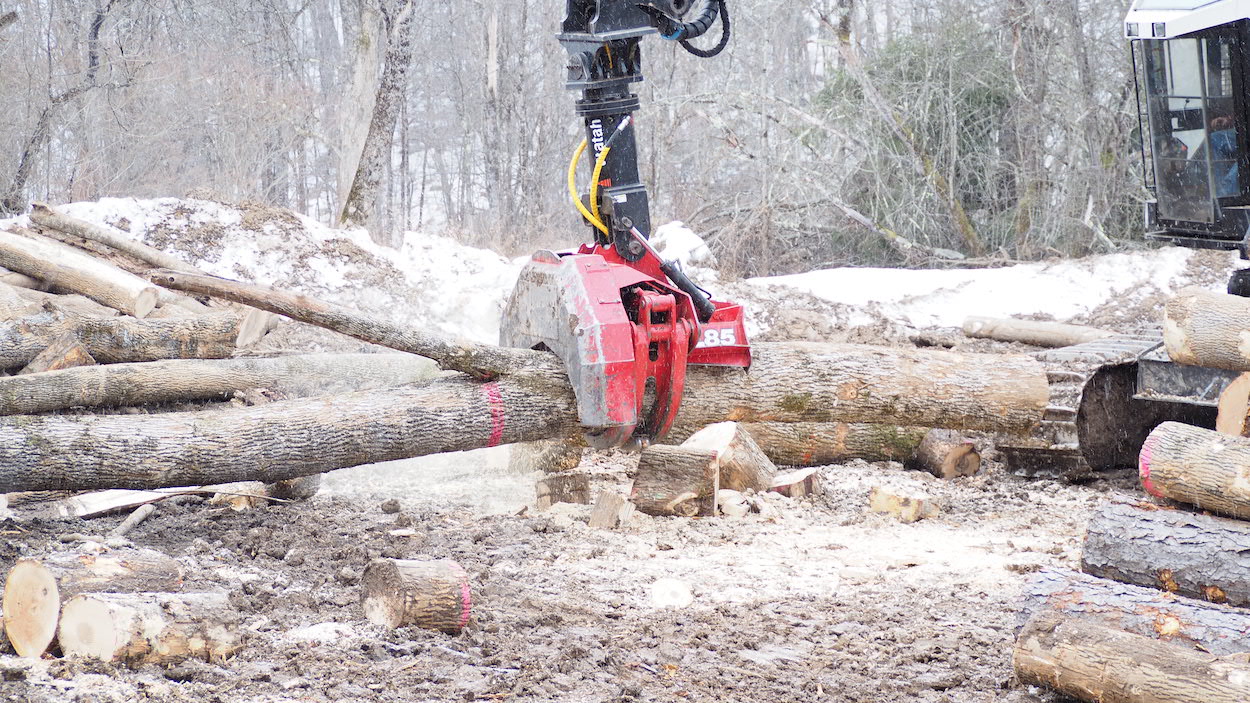You didn’t think you were going to take a chainsaw safety class and not fell a 15” tree, did you?

I had a rule: I was never going to use a chainsaw. They are powerful and dangerous and I know people who have been hurt by them. So when my co-worker and I learned about a chainsaw class for women, I was adamant I didn’t want to learn. Despite my protests, the woman organizing the class, Tracey Testo with Cornell Cooperative Extension’s Agroforestry Resource Center, convinced me to take it in her enthusiasm for it. The workshop was called “The Game of Logging: Level 1” and it is a method of teaching chainsaw use and tree cutting that emphasizes safety.
Friday was the day of the class. I toted along Dad’s chainsaw, an embarrassingly florescent purple and lime green chainsaw named “Wild Thing” (no joke – it actually says “wild thing” on the side of the saw). I was very jealous of my co-worker’s pink Husqvarna chainsaw. Her boyfriend owns a power tools dealership and ensured she was well kitted out. A dozen other women and I stood nervously around the instructor Bill Lindloff, a stereotypical woodsman who was strong and had a dry sense of humor. Bill had that way of picking on you that the more he made fun of you, the more you knew he liked and respected you. He didn’t say one word about my chainsaw.
All but 2 women hadn’t even started a chainsaw before. It was hard to imagine we would be cutting down a tree by the end of the day. In the morning, we learned about the parts of the saw and chain, how to sharpen our own chain, what kind of gas and oil to use, and how to start it. Starting my chainsaw turned out to be extremely difficult and I wasn’t able to start it myself all day.
After lunch we sauntered into the woods wearing our chainsaw chaps, helmet, ear muffs, and face visor. Naturally, I assumed we would be starting with a 6” diameter at breast height (dbh) tree. I should have realized that Bill was the “push you into the deep end of the pool to learn to swim” or the “take you to the top of the mountain and learn to ski on the way down” type of person. We were all given about a 15” dbh, massive beech to cut down. It was terrifying. Some trees were hollow, some were backward leaning, and some had massive dead branches just waiting to fall off and clock you on the head. Not only did we have to cut it down, we had to drop the tree in a pre-planned target location.
Bill taught us the HELP method. Hazards: identify any hazards such as dead limbs above you or any trees that your tree could get hung up on. Escape: plan your escape route at a 45-degree angle from the tree and at least 12 feet away (the majority of injuries occur within 12’ of the tree). Lean: compensate for any lean in the tree. Plan: plan your cut and calculate your hinge length and width.
Felling a tree involves math equations – the length of the hinge you cut is 80% of the tree dbh. The width of the hinge is 10% of the dbh. You cut your hinge perpendicular to where you want it to fall. If the trees leans to the left or right, you have to compensate for that. When cutting your hinge, you cut at a 70-degree angle into the tree and then straight across at the bottom to remove a wedge. Next you cut directly into the middle of the tree (aka a bore cut). Finally, you join the middle cut with a cut at the back of the tree. Then you run like crazy to get out of the way as the tree falls.
After one practice on a log, I had to cut my tree. It felt scary and amazing! I also felt a little cheated because my tree was so much of a leaner (leaning against the intended felling direction) that Bill had to help me drive wedges into the back. He ended up driving the final wedge, which knocked the tree over. Also, I never was able to get the chainsaw going by myself.

Still I was elated to have learned this new skill – something I NEVER thought I would be able to do! Being able to cut down and cut up trees was going to come in handy on my 10-acre property with lots of fence line, hedgerows, invasive trees, and old apple trees in need of pruning. I had been asking my landscaper all summer to cut down a small tree that was blocking the path for the mower, but he hadn’t yet gotten to it.
The next morning I was determined to cut down that tree all by myself. First challenge – getting the chainsaw started. After 20 minutes of trying, I had nothing and was exhausted. I called a neighbor – he wasn’t around. I called a friend – couldn’t get ahold of him. I tried setting the chainsaw on the ground and yanking the cord that way. After another 5 minutes of trying, success! Next, I sized up my tree – a 6” dbh elm. While the size was pretty easy, I had to fell it into a narrow opening between 2 fences. The tree also leaning to the left and slightly backward. I started the cut and with much pausing and checking, it came down exactly where I wanted it to! In that moment I felt all powerful. I spent the next hour cutting up the tree into firewood, and then worked on cutting some dead apple tree limbs, invasive buckthorn, and other trees that had fallen.

By the end of the day my shoulders were sore, but I felt omnipotent. I had cut down a tree with a chainsaw.
About the Author
Elizabeth Marks serves as a biologist for the United States Department of Agriculture Natural Resources Conservation Service (USDA NRCS) in the Hudson Valley (New York). She is a certified Holistic Management educator and works with landowners to improve soil health and biological diversity on their farm or forest. She lives in Chatham in a net-zero, energy efficient home she designed herself.








